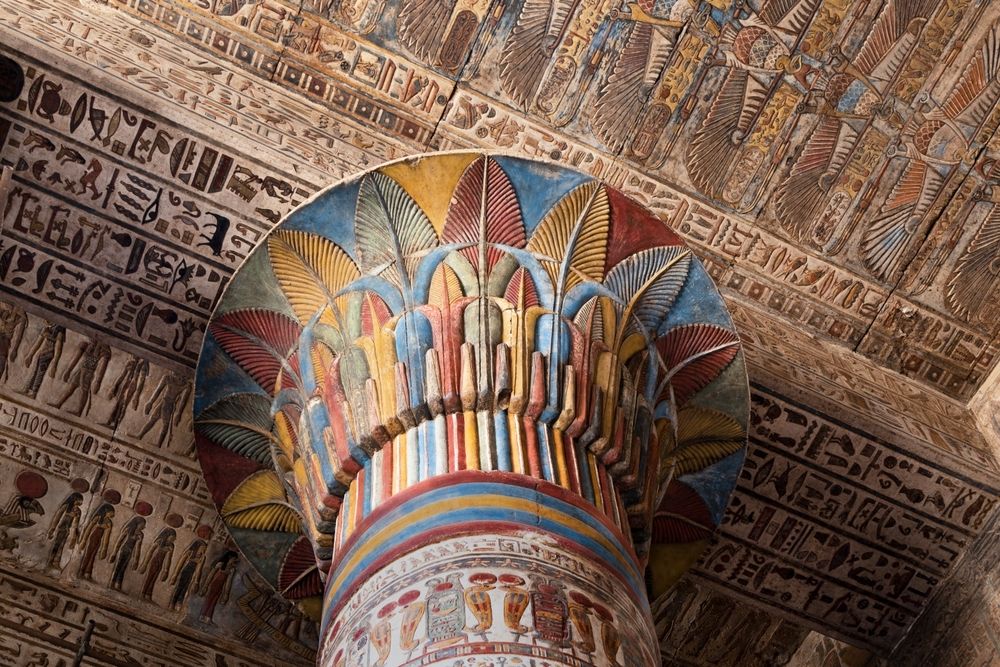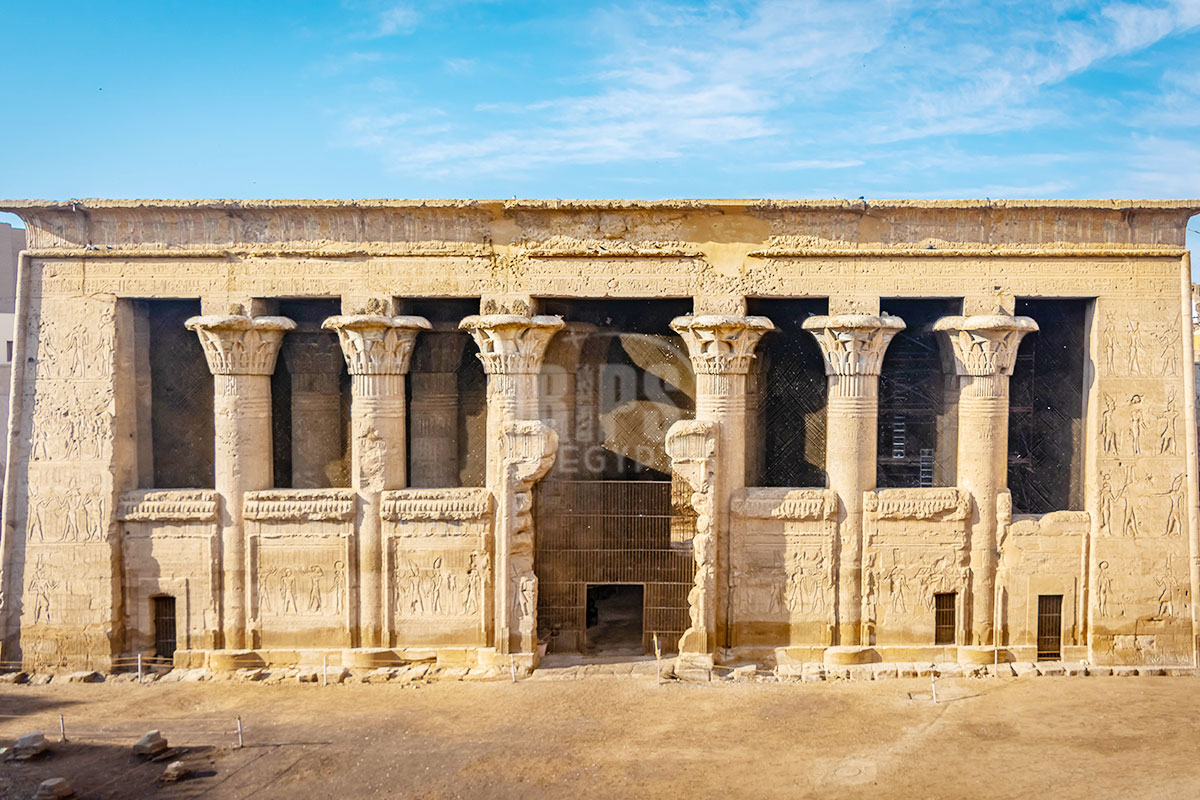The Enigmatic Beauty of Esna's Temple of Khnum

Introduction
History of Esna's Temple of Khnum
Welcome to the fascinating world of Esna's Temple of Khnum, where history breathes through its ancient stones. Constructed during the Ptolemaic period, around the 2nd century BCE, this temple is dedicated to Khnum, the ram-headed god of creation and inundation. As you stroll through the temple’s grounds, you can't help but feel the echoes of early Egyptian worship still resonating in the air. The history of this remarkable site is intertwined with the evolution of ancient Egyptian religion and culture.
Originally built to honour Khnum, it embodies a rich tapestry of deities, rituals, and the daily lives of the people who revered these gods. In fact, documentation from ancient texts and inscriptions provides evidence of how vital this temple was to the local community. The Roman influence is also apparent as subsequent rulers expanded and embellished the temple, incorporating elements of their own cultures.
As you dive deeper, you may discover that the temple’s walls are almost like a time capsule, showcasing the religious fervour of the period. It's said that the temple served not just as a place of worship but also as a hub for civic life, where people gathered for festivals and celebrations. For instance, the annual inundation of the Nile was celebrated with great enthusiasm, marking the agricultural calendar and reaffirming the community’s connection to gods like Khnum.
Significance of the Temple
The significance of the Temple of Khnum stretches beyond its impressive architecture and historical roots. It is an embodiment of ancient beliefs, practices, and the universal themes of life, death, and rebirth. Here are a few key points highlighting why this temple remains a crucial piece of Egypt's cultural heritage:
- Religious Importance: The temple played a central role in the religious practices of the time. Worshippers believed Khnum was responsible for creating humans on his potter's wheel, which granted him a prominent place in the hearts of the ancient Egyptians.
- Cultural Symbolism: The temple is a profound representation of the ancient Egyptian worldview, where gods influenced every aspect of life. From agriculture to childbirth, the divine connection to fertility and abundance was deeply ingrained in societal norms.
- Architectural Masterpiece: Beyond its spiritual significance, the Temple of Khnum stands as an architectural marvel. Its intricate carvings and detailed columns showcase the artistic prowess of the time, reflecting a deep appreciation for both beauty and religious devotion.
- Tourism and Education: Today, the temple serves as a key site for both tourists and scholars. Visitors from around the globe come to learn about the ancient practices, making it a vital part of Egypt’s tourism economy and educational outreach.
The Temple of Khnum at Esna is more than just a relic of the past; it's a living testament to the enduring legacy of ancient Egyptian civilization. As you delve deeper into the temple's history, you'll uncover stories of devotion, artistry, and the timeless human connection to the divine.

Architecture of the Temple of Khnum
Decorative Elements
Transitioning from the profound history and significance of the Temple of Khnum, let's explore the breathtaking architecture that truly sets this temple apart. The decorative elements of the temple serve as a canvas showcasing the skilled craftsmanship and artistic vision of ancient Egyptian artisans. As you approach the entrance, you are welcomed by towering columns adorned with intricate carvings that whisper tales of divine beings and mythological narratives. Each column is not just a support structure but a vessel of storytelling, featuring:
- Reliefs and Carvings: The temple walls are covered in exquisite reliefs depicting various deities, including Khnum himself, often represented with a ram's head. These carvings were not just ornamental; they were integral to the religious practices, as they invoked the presence of the gods.
- Sculptures: Statues of Khnum, crafted with meticulous detail, can be found throughout the temple. These sculptures often illustrate the god in various poses, capturing his essence and importance in the eyes of the worshippers.
- Paintings and Colours: The original pigments used to create vibrant scenes have worn over centuries but can still be glimpsed in certain areas. Bright hues were essential in ancient Egyptian art, believed to connect the earthly to the divine.
The decorative elements convey messages and insights into the daily lives of the ancient Egyptians while enhancing the temple's spiritual ambience. It’s easy to imagine locals gathering at this magnificent site, marvelling at the beauty that surrounded them as they sought blessings from Khnum.
Structural Design
Now, moving on to the structural design of the Temple of Khnum, you'll find that it reflects a sophisticated understanding of architecture and engineering. The layout itself is carefully planned, demonstrating both functionality and devotion.
- Hypostyle Hall: One of the temple's highlights is the grand hypostyle hall, characterized by its vast space supported by towering columns. This area served as a gathering space for worshippers and was designed to evoke a sense of awe. The height of the columns creates a feeling of openness, allowing natural light to filter through and illuminate the sacred space.
- Sanctuary: At the heart of the temple lies the sanctuary, a sacred space reserved for the rituals and offerings to Khnum. This area represents the spiritual core of the temple, meticulously designed to facilitate connection with the divine.
- Axial Orientation: The temple’s design follows a strict axial orientation, aligning perfectly with the cardinal points. This careful orientation is not just a feat of engineering but also a spiritual practice, reinforcing the link between the temple and the cosmos.
As you walk through the temple, you can feel the history wrapped around the structure itself. The architectural elements seamlessly blend function and artistry, inviting visitors to delve deeper into the spiritual journey that this sacred site offers.
The architecture of the Temple of Khnum goes beyond mere aesthetics; it embodies the religious beliefs, artistic creativity, and engineering prowess of ancient Egypt. Whether you are standing under the immense columns or admiring the delicate carvings, the temple is a splendid reminder of a civilization that sought to connect with the divine through every detail.

Religious Practices at the Temple
Worship of Khnum
As we transition from the architectural marvels of the Temple of Khnum, let’s delve deeper into the vibrant religious practices that breathed life into this ancient site. Worship of Khnum was not just a mere act of reverence; it was a profound connection between the divine and the daily lives of the local people. Khnum, as the ram-headed god, held significance as the creator deity who fashioned humans from clay on his potter's wheel. This belief lent an intimate, personal connection to worship, as families sought Khnum's blessings for fertility and regeneration. The worship practices often involved:
- Offerings: Devotees would bring offerings of food, drink, and incense to the temple. These acts of devotion were essential, believed to nourish the god and invite his blessings upon the people. Fresh bread, wine, and fragrant oils were particularly popular choices.
- Prayers and Incantations: Worshippers engaged in prayers and recited incantations, often asking for personal favours or community needs. You might imagine villagers gathering in harmonious voices, weaving their hopes into the air.
- Pilgrimages: People would travel from nearby towns to visit the temple, viewing it as a sacred site where their prayers would be most potent. Pilgrimages strengthened community bonds and a shared sense of purpose.
Khnum was seen as a protector, especially during the annual Nile inundation. The worship practices surrounding this event were vibrant and communal, ensuring prosperity for the agricultural calendar and the well-being of families.
Rituals and Ceremonies
The heart of the temple's religious life was undoubtedly found in its rituals and ceremonies, steeped in tradition and meaning. These occasions were pivotal in reaffirming the community’s connection with Khnum and were essential to the fabric of daily life.
- Festival of the Inundation: One of the major events in the temple’s religious calendar was the Festival of the Inundation. This annual celebration coincided with the flooding of the Nile, marking an important time for fertility and renewal. The temple would be filled with music, dancing, and vibrant processions, inviting townsfolk to engage in joyous activities.
- Daily Rituals: Each day, priests performed rituals to awaken the god. These rituals included the opening of the temple doors, lighting incense, and conducting daily offerings. The meticulous nature of these practices ensured that Khnum remained vigilant and benevolent.
- Healing Ceremonies: The temple also served as a place of healing, with rituals designed to invoke Khnum's restorative powers. Devotees believed that participating in these ceremonies could lead to physical and spiritual healing, making the temple a sanctuary for those in need.
- Sacred Dramas: To recount the divine stories, sacred dramas and theatrical performances were staged. These dramatizations narrated the myths surrounding Khnum, allowing worshippers to engage intimately with divine narratives and capturing the imagination of all present.
Through these multifaceted practices, the Temple of Khnum became a cornerstone of community life, marrying the sacred with the everyday. Engaging in these rituals was not only about seeking divine intervention but also about forging connections with each other through shared beliefs and traditions. In essence, the religious practices at the Temple of Khnum illustrate a deep-rooted faith, showcasing the community's dedication to their god and belief in the interplay of the cosmic order.
The threads of worship weaved through this temple continue to echo in the very fabric of ancient Egyptian spirituality, offering modern visitors a glimpse into a world steeped in richness and tradition.
Hieroglyphics and Carvings
Interpretation of Symbols
As we move from the living practices of worship at the Temple of Khnum, let’s immerse ourselves in the captivating world of hieroglyphics and carvings that adorn its walls. These intricate symbols are not merely decorative; they serve as a profound language of expression, each character loaded with meaning and significance.
Hieroglyphics, often described as the writing of the gods, were used to communicate religious, historical, and cultural narratives. The interpretation of these symbols requires a keen understanding of both context and form. Here are a few key aspects to consider:
- Phonetic Sounds: Many hieroglyphs represent sounds similar to our letters. For instance, the symbols for water (represented by a hieroglyph of a wavy line) could stand for the sound 'n,' intertwining with other symbols to create words related to the Nile, a vital source of life.
- Logographic Symbols: Some hieroglyphs represent entire words or concepts. The image of an ankh, for example, symbolises life and is often featured in religious texts, signifying the Egyptians’ desire for immortality.
- Determinatives: Certain symbols are used to clarify meaning and assist in interpretation without being pronounced. For example, a symbol depicting a deity may accompany an offering to indicate the substance's religious context.
Understanding these symbols is like solving a puzzle, allowing you to uncover the intricacies of ancient beliefs and practices. The walls of the temple effectively communicate a narrative that binds the community together through faith, tradition and shared history.
Stories Depicted
Delving deeper, the carvings found throughout the Temple of Khnum narrate stories that weave together divine interaction and human experience. These ancient tales offer insights into the values and beliefs that shaped Egyptian society. Here are some notable themes and stories depicted in the temple carvings:
- Creation Myths: Many carvings illustrate the myth of Khnum creating humans from clay. You might see scenes where Khnum shapes figures on his potter's wheel, symbolising the divine connection between creator and creation.
- Festivals and Offerings: Carvings celebrate significant religious festivals, depicting worshippers presenting offerings and engaging in rituals. These images encapsulate the communal aspect of worship, capturing moments of joy and devotion shared among believers.
- Royal Decrees: Hieroglyphics also preserve important historical records, such as royal decrees or triumphs. These narratives often depict pharaohs making offerings to deities, reinforcing their role as intermediaries between the gods and the people.
- Animals in Religion: The presence of animals in the carvings, like rams or crocodiles, often signifies specific attributes or roles within the Egyptian pantheon. For instance, the ram represents strength and virility and aligns perfectly with Khnum’s identity.
These stories reflect a society steeped in mythology, where the lines between the human and divine blurred seamlessly. As you explore the carvings, you become part of a living history, discovering the shared dreams, fears, and aspirations of an entire civilization. In conclusion, the hieroglyphics and carvings at the Temple of Khnum serve as an invaluable bridge connecting us to the ancient world.
They tell tales of creation, faith, and human experience, allowing us to glimpse the shared spirituality that has enriched human history. With every symbol and story, we are reminded of the profound human connection to the divine, awakening appreciation for a rich cultural legacy that continues to inspire.
Restoration Efforts
Preservation Challenges
As we conclude our exploration of the hieroglyphics and carvings at the Temple of Khnum, it’s essential to pivot towards the significant restoration efforts that are crucial for the preservation of this cultural treasure.
While the temple stands as a monument to ancient Egyptian history, it faces multiple challenges that threaten its structural integrity and historical value. One of the foremost challenges in preserving the Temple of Khnum involves environmental factors. Over centuries, natural elements have taken their toll on the structure, causing:
- Erosion: Wind and rain can erode the stone surfaces and artistic carvings, slowly wearing away the intricate details that tell the temple's story. The temple's location, close to the Nile, brings additional humidity, which can lead to deterioration.
- Pollution: In recent years, urbanization and increasing tourism have introduced pollution, which contributes to the degradation of the temple's stonework. The salts and chemicals in air pollution can seep into the stone, causing flaking and discolouration.
- Vandalism and Neglect: Unfortunately, the effects of vandalism and neglect have also taken a toll. Graffiti and unmonitored access have led to physical damage, undermining the efforts of conservationists striving to maintain this historic site.
In light of these challenges, the task of restoring and preserving the temple becomes a race against time, demanding careful planning, resources, and expertise.
Impact of Conservation Projects
Despite these obstacles, restoration efforts have made notable strides in sustaining the Temple of Khnum for future generations. A range of conservation projects have been launched, often involving dedicated teams of archaeologists, conservators, and volunteers who share a profound love for Egypt's cultural heritage. The impact of these initiatives is substantial and manifests in several ways:
- Structural Stabilization: One of the primary goals of restoration has been to stabilize the temple’s structure. Engineers and conservators perform extensive analyses to ensure that the building's foundation remains solid, mitigating the effects of erosion while allowing the natural beauty of the carvings to shine through.
- Documentation and Research: Every restoration project begins with meticulous documentation. This process not only preserves the history of the temple but also generates valuable data for future research, offering insights into ancient construction techniques and artistic expressions.
- Community Involvement: The conservation projects often engage local communities, raising awareness about the temple’s significance and promoting cultural heritage. Workshops and educational programmes encourage locals to take pride in their history, fostering a sense of ownership and stewardship.
- Eco-Friendly Practices: Modern conservation efforts typically incorporate environmentally friendly methods. By using natural materials and sustainable techniques, conservationists aim to support the temple's integrity while reducing ecological impacts.
In conclusion, the restoration efforts at the Temple of Khnum serve as a powerful testament to the enduring value of cultural preservation. Faced with numerous challenges, dedicated individuals and communities are tirelessly working to ensure that the legacy of this magnificent temple remains vibrant.
As we appreciate this living piece of history, it’s heartening to know that future generations will continue to marvel at the beauty and significance encapsulated within its ancient walls. The efforts to safeguard such treasures remind us of our collective responsibility to protect such irreplaceable fragments of our shared human heritage.
